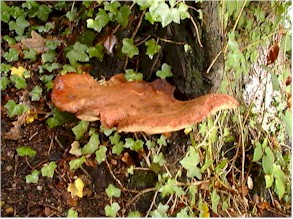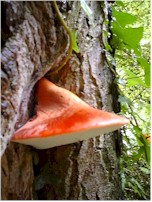 Common Name(s):
Common Name(s):Beefsteak Fungus (Fistulina hepatica) |
 Common Name(s):
Common Name(s):
Scientific Name(s):
Fistulina hepaticaType:
FungusPrinciple Host Trees & Shrubs: Mainly oak and chestnut.
Description, Development & Diagnosis:
 The brackets produced by this fungus appear annually in late-summer to autumn.
The fungus is parasitic, feeding upon the heart wood of its host tree, it creates the
fruiting bodies (brackets) as part of its reproduction process; it is the fruiting bodies
that produce and release the spores into the air.
The brackets produced by this fungus appear annually in late-summer to autumn.
The fungus is parasitic, feeding upon the heart wood of its host tree, it creates the
fruiting bodies (brackets) as part of its reproduction process; it is the fruiting bodies
that produce and release the spores into the air.
The bracket can be tongue shaped, is soft, rubbery and succulent. The upper surface is red-brown in colour with a pale white underside. The flesh has a dark pink colour and is juicy resembling the constituency of raw meat.
It is normally found low down on the tree trunk. Edible and considered good to eat. [Please read note at foot of page]
Significance:
This fungus is common and widespread in Britain. It is a parasitic decay fungus producing a brown rot within its host tree. Beefsteak produces a colour change within chestnut and oak heartwood (called 'brown oak') which is much sought after by wood users.
Control:
None.
Please Note: Many Fungi are toxic and individual reactions to them vary widely. Do not touch or eat fungi unless you have accurately identified them. Chris Skellern can not accept any legal responsibility or liability for errors in identification or for individual reactions to the consumption of fungi.
| Further Information. |
© 2001 Chris Skellern. AIE. Home | News | A-Z Index | Resources | Contact AIE | Terms of Use